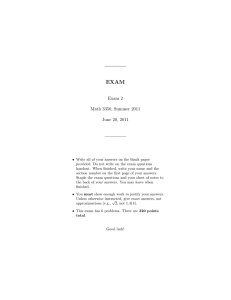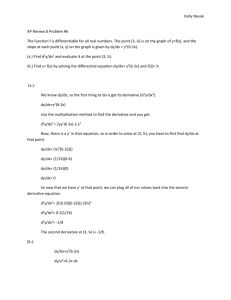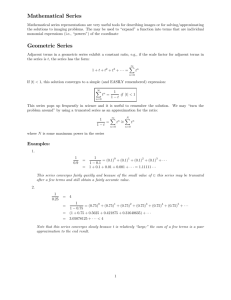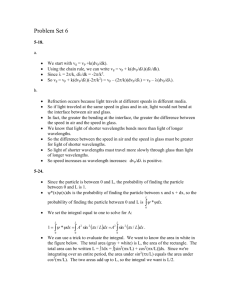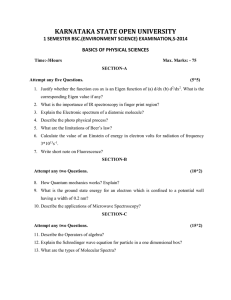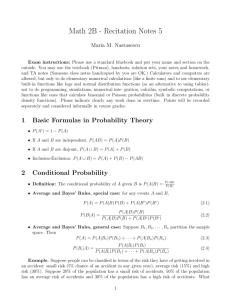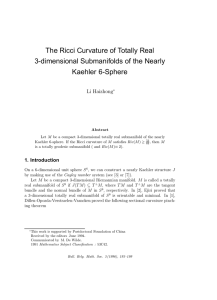ON TOTALLY REAL MINIMAL SUBMANIFOLDS IN COMPLEX PROJECTIVE SPACE
advertisement
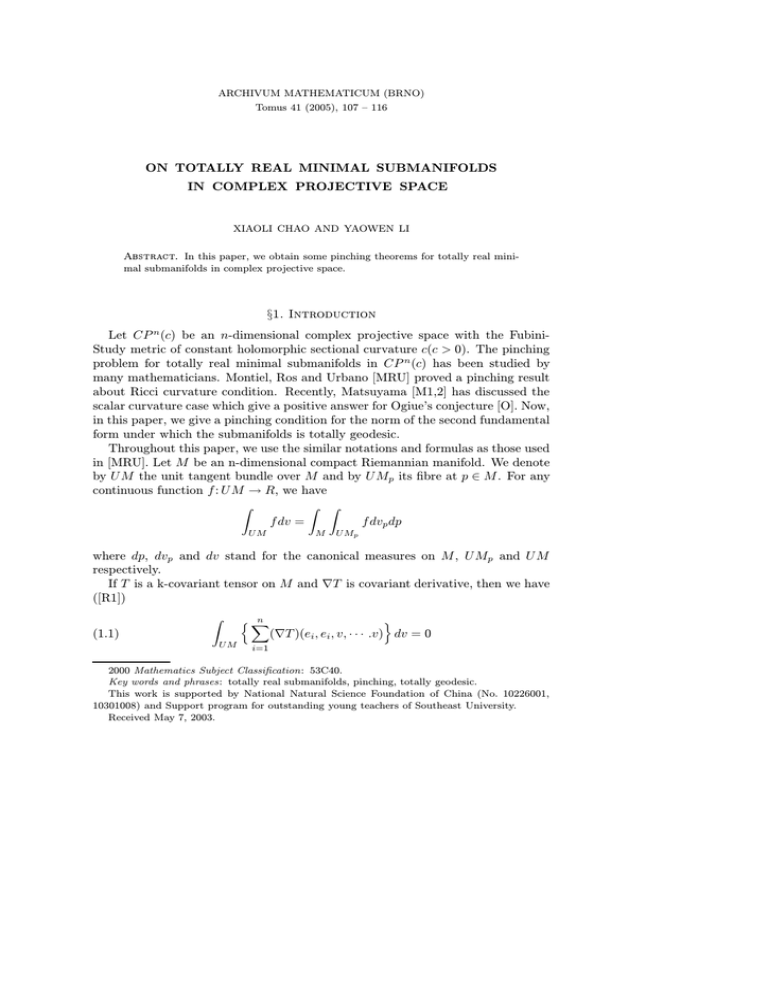
ARCHIVUM MATHEMATICUM (BRNO)
Tomus 41 (2005), 107 – 116
ON TOTALLY REAL MINIMAL SUBMANIFOLDS
IN COMPLEX PROJECTIVE SPACE
XIAOLI CHAO AND YAOWEN LI
In this paper, we obtain some pinching theorems for totally real minimal submanifolds in complex projective space.
§1. Introduction
n
Let CP (c) be an n-dimensional complex projective space with the FubiniStudy metric of constant holomorphic sectional curvature c(c > 0). The pinching
problem for totally real minimal submanifolds in CP n (c) has been studied by
many mathematicians. Montiel, Ros and Urbano [MRU] proved a pinching result
about Ricci curvature condition. Recently, Matsuyama [M1,2] has discussed the
scalar curvature case which give a positive answer for Ogiue’s conjecture [O]. Now,
in this paper, we give a pinching condition for the norm of the second fundamental
form under which the submanifolds is totally geodesic.
Throughout this paper, we use the similar notations and formulas as those used
in [MRU]. Let M be an n-dimensional compact Riemannian manifold. We denote
by U M the unit tangent bundle over M and by U Mp its fibre at p ∈ M . For any
continuous function f : U M → R, we have
Z
Z Z
f dv =
f dvp dp
UM
M
U Mp
where dp, dvp and dv stand for the canonical measures on M , U Mp and U M
respectively.
If T is a k-covariant tensor on M and ∇T is covariant derivative, then we have
([R1])
(1.1)
Z
UM
n
nX
i=1
o
(∇T )(ei , ei , v, · · · .v) dv = 0
2000 Mathematics Subject Classification: 53C40.
Key words and phrases: totally real submanifolds, pinching, totally geodesic.
This work is supported by National Natural Science Foundation of China (No. 10226001,
10301008) and Support program for outstanding young teachers of Southeast University.
Received May 7, 2003.
108
X. L. CHAO AND Y. W. LI
where e1 , . . . , en is an orthonormal basis of Tp M , p ∈ M .
Suppose now that M is isometrically immersed in an (n + p)-dimensional Rien+p
mannian manifold M
. We denote by h, i the metric of M as well as that induced
on M . Let σ be the second fundamental form of the isometrically immersion and
Aξ the Weingarten endomorphism for a normal vector ξ. If Tp M and Tp⊥ M denote
the tangent and normal spaces to M at p, one can define
L: Tp M → Tp M
and T : Tp⊥M × Tp⊥ M → R
by the expressions
Lv =
n
X
Aσ(v,ei ) ei
and T (ξ, η) = trace Aξ Aη
i=1
where e1 , . . . , en is an orthonormal basis of Tp M . Then L is a self-adjoint linear
map and T a symmetric bilinear map.
There are many submanifolds satisfying T = kh, i. Obviously, hypersurfaces
represent a trivial case. In CP n+p (c), a Kaehler submanifold of order {k1 , k2 } for
some natural numbers k1 and k2 is one submanifold of this type ([R3]). In this
paper, we have a pinching theorem for this kind of submanifolds as following:
Theorem 3.1. Let M n be a totally real minimal submanifold with T = kh, i in
CP n+p (c). If
2
nc(n + 2p)(n + 4)
σ <
,
4(n + 2)(n + 4) + n(n + 4)2 + 4n
then M must be totally geodesic.
§2. Some Lemmas
In this section, we will prove some lemmas which will be used later. First, we
give the following modified version of Simons’ formula which generalizes a result
from [MRU]. Now we suppose that M is a curvature-invariant submanifold of M ,
i.e., R(X, Y )Z ∈ Tp M for all X, Y , Z ∈ Tp M , being R the curvature operator of
M.
Lemma 2.1 [LC]. Let M be an n-dimensional compact curvature-invariant submanifold with parallel mean curvature vector isometrically immersed in an (n+p)n+p
dimensional Riemannian manifold M
. Then we have
Z
n
n
nX
X
(∇σ)(ei , v, v)2 +
0=
hσ(ei , ei ), Aσ(v,v) vi
UM
i=1
i=1
2
+ (n + 4)Aσ(v,v) v − 4hLv, Aσ(v,v) vi − 2T (σ(v, v), σ(v, v))
+
n
hX
i=1
R(ei , v, σ(v, ei ), σ(v, v)) + 2
n
X
i=1
R(ei , v, v, Aσ(v,ei ) v)
io
dv
Remark. When the immersion is minimal, Lemma 2.1 is due to [MRU].
Remark. It’s clear that submanifolds in real space forms, Kahler, and totally
real submanifolds in complex space forms are curvature-invariant.
TOTALLY REAL MINIMAL SUBMANIFOLDS
109
Lemma 2.2. Let M be an n-dimensional compact submanifold isometrically imn+p
. Then, for ∀p ∈ M , we have:
mersed in a Riemannian manifold M
Z
hLv, Aσ(v,v) vi dvp
i)
U Mp
Z
Z
2
1
2
Lv dvp +
=
hσ(v, v), ξi dvp
n + 2 U Mp
n + 2 U Mp
Z
σ(v, v)2 dvp
ii)
U Mp
2
=
n+2
1
hLv, vi dvp +
n+2
U Mp
Z
iii)
Z
iv)
Where ξ =
Z
Pn
i=1
Z
1
hLv, vi dvp =
n
U Mp
1
hσ(v, v), ηidvp =
n
U Mp
Z
n
X
hσ(v, v), σ(ei , ei )i dvp
U Mp i=1
Z
U Mp
n
X
2
σ dvp
hσ(ei , ei ), ηi dvp
U Mp i=1
σ(ei , Lei ) and η is a fixed vector in normal bundle.
Proof. Let α1 be the 1-form on U Mp defined by
α1 (e) = hLv, Aσ(v,v) ei,
v ∈ U Mp ,
e ∈ Tv U Mp
For any v ∈ U Mp , let e1 , . . . , en−1 , en = v be an orthonormal basis of Tp M . Then
2
(δα1 )(v) = −(n + 2)hLv, Aσ(v,v) vi + 2Lv + hσ(v, v), ξi .
Integrating it over U Mp , we obtain i).
ii), iii) and iv) are obtained by using the same technique for the 1-forms α2 , α3
and α4 on U Mp defined by
α2v (e) = hσ(v, v), σ(v, e)i
α3v (e) = hLv, ei
α4v (e) = hσ(v, e), ηi
Lemma 2.3. Let M be an n-dimensional compact submanifold isometrically imn+p
. Then we have
mersed in a Riemannian manifold M
Z
Z
Aσ(v,v) v 2 dvp ≥ 2
hLv, Aσ(v,v) vi dvp
n + 2 U Mp
U Mp
Z
1
+
hAσ(ei ,ei ) v, Aσ(v,v) vi dvp
n + 2 U Mp
110
X. L. CHAO AND Y. W. LI
Proof. Let 4 denote the Laplace operator on S n−1 . Then, for the function
f : U Mp → Tp M defined by f (v) = Aσ(v,v) v, we have
(4f )(v) = −3(n + 1)Aσ(v,v) v + 4Lv + 2Aσ(ei ,ei ) v .
Since U Mp is a (n − 1)-dimensional sphere, the first eigenvalue of −4 = ∇∇ei ei −
∇ei ∇ei is n − 1. Then
Z
Z
2
f dvp
−
h4f, f i dvp ≥ (n − 1)
U Mp
U Mp
and the lemma follows.
Let α be a 1-form on U Mp defined by
αv (e) = hAσ(v,v) e, Aσ(v,v) vi
where v ∈ U Mp , and e ∈ Tv U Mp . If e1 , . . . , en−1 is an orthnormal basis of Tv U Mp ,
then the codifferential of α is
(δα) =
n
X
ei · αv (ei )
i=1
2
= −(n + 4)Aσ(v,v) v + 2hLv, Aσ(v,v) vi
n
X
hAσ(v,v) ei , Aσ(v,ei ) vi ,
+ T (σ(v, v), σ(v, v)) + 2
i=1
where e1 , . . . , en−1 , en = v is an orthonormal basis of Tp M . Now integrating the
above equality over U Mp and using divergence theorem, we have
2
Z
U Mp
n
nX
i=1
o
hAσ(v,v) ei , Aσ(v,ei ) vi dvp
= (n + 4)
(2.1)
−
Z
Z
U Mp
Aσ(v,v) v 2 dvp − 2
Z
hLv, Aσ(v,v) vi dvp
U Mp
T (σ(v, v), σ(v, v)) dvp
U Mp
In a similar way, for the 1-form α defined by
αv (e) = hAσ(v,e) v, Aσ(v,v) vi ,
we have
(δα)(v) =
n
X
i=1
2
{2Aσ(v,ei ) v + hAσ(v,ei ) v, Aσ(v,v) ei i
2
+ hAσ(ei ,ei ) v, Aσ(v,v) vi} − (n + 4)f (v) + hLv, f (v)i .
TOTALLY REAL MINIMAL SUBMANIFOLDS
111
Integrating this and using (2.1), we get
2
Z
Z
n
X
Aσ(v,e ) v 2 dvp =
i
nn + 4
f (v)2 − hAnH v, f (v)i
2
U Mp
o
1
+ T (σ(v, v), σ(v, v)) dvp
2
U Mp i=1
(2.2)
By (2.1),(2.2) and
n
X
n
n
X
2 1 X
Aσ(v,v) ei 2
2
hAσ(v,ei ) v, Aσ(v,v) ei i ≤ a
Aσ(v,ei ) v +
a i=1
i=1
i=1
=a
(2.3)
n
X
Aσ(v,e ) v 2 1 T (σ(v, v), σ(v, v)) ,
i
a
i=1
By (2.1),(2.2) and (2.3), we have, for ∀ b > 0,
Z
n
2
b(n + 4) f (v) − 2hLv, f (v)i
n+4−
4
U Mp
o
b 1
(2.4)
T (σ(v, v), σ(v, v)) dv ≤ 0 .
− 1+ +
4 b
Now, we can prove the following lemma:
n+p
be a compact Riemannian immersion. Then we
Lemma 2.4. Let M n → M
have
Z
(1)
(n + 2)hAH v, f (v)i dvp
U Mp
=
(2)
(3)
Z
Z
U Mp
n
o
n X
hAH ei , Aσ(v,ei ) vi + T (H, σ(v, v)) dvp
2
i=1
hAH v, Lvi dvp =
U Mp
Z
Z
hAH v, Lvi dvp =
U Mp
=
(4)
Z
n
X
1
n
Z
1
n
Z
n
X
hAH ei , Lei i dvp
U Mp i=1
hH · ξi dvp
U Mp
T (H < σ(v, v))dvp =
U Mp
hAH ei , Aσ(v,ei ) vi dvp
U Mp i=1
Z
T (H, H) dvp
U Mp
112
X. L. CHAO AND Y. W. LI
Z
(5)
(n + 2)T (σ(v, v), σ(v, v)) dvp
U Mp
=
(6)
(7)
(8)
Z
U Mp
Z
Z
{nT (H, σ(v, v)) + 2
U Mp
1
T (σ(v, ei ), σ(v, ei )) dvp =
n
i=1
U Mp
Z
U Mp
n
T (σ(v, v), σ(v, v)) dvp =
U Mp
(9)
Z
n
X
T (σ(ei , ej ), σ(ei , ej )) dvp
U Mp i,j=1
o
1
2
T (H, H) +
hH, ξi dvp
n+2
n(n + 2)
Z
n n
T (H, H)
n+2
U Mp
+
Z
T (σ(v, ei ), σ(v, ei ))} dvp
i=1
n
X
hAH v, f (v)i dvp =
Z
n
X
n
o
X
2
T (σ(ei , ej ), σ(ei , ej )) dvp
n(n + 2) i,j=1
2
b(n + 4) ) f (v) dvp
4
U Mp
Z
n
o
b 1
b
1+ +
T (σ(v, v), σ(v, v)) − 1 +
nhAH v, f (v)i dvp ,
≤
4 b
2
U Mp
(2 −
for each b.
Proof. By taking some proper 1-form on U Mp respectively as above, we can
obtain (1) ∼ (6) and then (7) and (8) as their corollaries. Using Lemma 2.3, (2.4)
implies (9).
Remark. When b(> 0) is small, (9) gives a estimation of the upper bound of
f (v)2 .
§3. Totally real submanifolds with
T = kh, i in complex projective spaces
There are many submanifolds satisfying T = kh, i. Obviously, hypersurfaces
represent a trivial case. In CP n+p (c), a Kaehler submanifold of order {k1 , k2 } for
TOTALLY REAL MINIMAL SUBMANIFOLDS
113
some natural numbers k1 and k2 is one submanifold of this type ([R3]). Let M n be
a totally real minimal submanifold with T = kh, i immersed in CP n+p (c). Then
P (R) =
n
X
R(ei , v, σ(v, ei ), σ(v, v)) + 2
i=1
n
−
R(ei , v, v, Aσ(v,ei ) v)
i=1
c
= hLv, vi −
2
(3.1)
n
X
n
2 c X
c σ(v, v) +
hσ(v, v), Jei i2
2
4 i=1
cX
hJv, σ(ei , ei )ihJv, σ(v, v)i .
4 i=1
Now, we define a map g 1 : U Mp → Tp M by
g 1 (v) = Aσ(v,v) v − Lv .
By a direct computation, we have
(−4g 1 )(v) = 3(n + 1)f (v) − (n + 3)Lv − 2nAH v .
Here 4 is the Laplacian of U Mp . Since
Z
1
R
U Mp
g 1 (v)dvp = 0, we get
1
h(−4g )(v), g (v)i ≥ (n − 1)
U Mp
Z
U Mp
1 2
g (v) .
Then, the above relation gives
Z
U Mp
2
{(2n + 4)f (v) − (2n + 8)hLv, f (v)i
2
− 2nhf (v), AH vi + 4Lv + 2nhLv, AH vi} dvp ≥ 0 .
(3.2)
In a similar way, for the 1-form g 2 (v) = f (v) + Lv, we have
Z
U Mp
2
{(2n + 4)f (v) − 2nhLv, f (v)i
2
− 2nhf (v), AH vi − 4Lv − 2nhLv, AH vi} dvp ≥ 0 .
(3.3)
By (3.2) and (3.3), we get
Z
(3.4)
U Mp
2
{(2n + 4)f (v) − (2kn + 4k + 4)hLv, f (v)i
2
− 2nhf (v), AH vi + 4k Lv − 2nkhLv, AH vi} dvp ≥ 0 .
114
X. L. CHAO AND Y. W. LI
2
, we have
Since M is minimal, by (3.4) with k = − n+2
Z
U Mp
4
(n + 2)2
f (v)2 dvp ≥
Z
U Mp
2
Lv dvp .
From this and Lemma 2.2 i) we get
Z
(3.5)
U Mp
2
n+2
f (v)2 dvp ≥
Z
hLv, f (v)i dvp .
U Mp
From (3.1),(3.5) and Lemma 2.1 we have
0=
(3.6)
Z
UM
n
nX
(∇σ)(ei , v, v)2 + (n + 4)f (v)2
i=1
− 4hLv, f (v)i − 2T (σ(v, v), σ(v, v))
n
io
hc
2 c X
c
hσ(v, v), Jei i2 dv
+ hLv, vi − σ(v, v) +
2
2
4 i=1
Z
n
n X
(∇σ)(ei , v, v)2 + nc σ(v, v)2
≥
4
UM
i=1
o
2
− nf (v) − 2T (σ(v, v), σ(v, v)) dv .
4
in formula (9) of Lemma
Assuming now that M is minimal, and putting b = n+4
2.4,we obtain
Z
Z
f (v)2 dvp ≤ 1 + 1 + n + 4
(3.7)
T (σ(v, v), σ(v, v)) dvp .
n+4
4
U Mp
U Mp
By (3.6), (3.7) and the fact that T =
0≥
Z
UM
+
2
σ 2p+n g
n
nX
(∇σ)(ei , v, v)2
h nc
4
we get
i=1
−
n(1 +
1
n+4
+
n+4
4 )
2p + n
o
+ 2 2 i σ · σ(v, v)2 dv .
From this we immediately have
Theorem 3.1. Let M n be a totally real minimal submanifold with T = kh, i in
CP n+p (c). If
(3.8)
2
σ <
nc(n + 2p)(n + 4)
,
4(n + 2)(n + 4) + n(n + 4)2 + 4n
TOTALLY REAL MINIMAL SUBMANIFOLDS
115
then M must be totally geodesic.
Remark. Xia [X] gave a pinching constant nc
6 without the assumption: T = kh, i.
n(n+4)
2
n
n
When p > 12 + 3 + 3(n+4) − 6 , our pinching constant is larger than Xia’s.
Remark. When the target manifold is the quaternionic space form QP n+p (c),
we have also a corresponding result, i.e., changing the factor n + 2p in (3.8) to
3n + 4p. So our result is better than that of [Sh1] in case when p is large enough.
Remark. B. Y. Chen and K. Ogiue ([CO]) had proved that, for a submanifold
M of nonflat complex space form, M is curvature-invariant if and only if M is
holomorphic or totally real submanifold. So we can use Lemma 2.1 in the proof
of Theorem 3.1.
Acknowledgment. The authors would like to thank the referee for careful reading of the manuscript and very helpful suggestions.
References
[CO]
Chen, B. Y. and Ogiue, K., On totally real submanifolds, Trans. Amer. Math. Soc. 193
(1994), 257–266.
[LC]
Li, Y. W and Chao, X. L., A modified version of Simons formula, preprint (2001).
[M1]
Matsuyama, Y., Curvature pinching for totally real submanifolds of complex projective
space, J. Math. Soc. Japan 52 (2000), 51–64.
[M2]
Matsuyama, Y., On totally real submanifolds of a complex projective space, Nihonkai
Math. J. 13 (2002), 153–157.
[MRU] Montiel, S., Ros, A. and Urbano, F., Curvature pinching and eigenvalue rigidity for
minimal submanifolds, Math. Z. 191 (1986), 537-548.
[O]
Ogiue, K., Recent topics of differential geometry, Mathematics: the publication of the
Mathematical Society of Japan 39 (1987), 51–64.
[R1]
Ros, A., A characterization of seven compact Kahler submanifolds by holomorphic pinching, Ann. Math. 121 (1985), 377–382.
[R2]
Ros A., Eigenvalue inequalities for minimal submanifolds and P-manifolds, Math. Z. 187
(1984), 393–404.
[R3]
Ros, A., On spectral geometry of Kaehlar submanifolds, J. Math. Soc. Japan 36 (1984),
433–448.
[Si]
Simons, J., Minimal verieties in Riemannian manifolds, Ann. Math. 88 (1968), 62–65.
[Sh1]
Shen, Y. B., Totally real minimal submanifolds in quaternionic projective space, Chin.
Ann. Math. 14B (1993), 297–306.
[Sh2]
Shen, Y. B., On scalar curvature of totally real minimal submanifolds, Chin. Ann. Math.
12A (1991), 573–577.
[Sh3]
Shen, Y. B., On curvature pinching for minimal and Kahler submanifolds with isotropic
second fundamental form, Chin. Ann. Math. 12B (1991), 454–463.
116
X. L. CHAO AND Y. W. LI
[Ub]
Urbano F., Totally real submanifolds, Geometry and Topology of Submanifolds, Proceedings (1987), 198–208.
[X]
Xia, C. Y., On the minimal submanifolds in CP m (c) and S n (1), Kodai Math. J. 15
(1992), 141–153.
" $#%&')(*,+-+-.-/ 0 1 &
" $#%&')(*,+-+-.!4 0 1 &
E-mail 5 xlchao@seu.edu.cn
6 7 98:
" $#%&')(*,+-+-.-; 0 1 &
!
" $#%&'2" 3 !
" $ #%&' !
